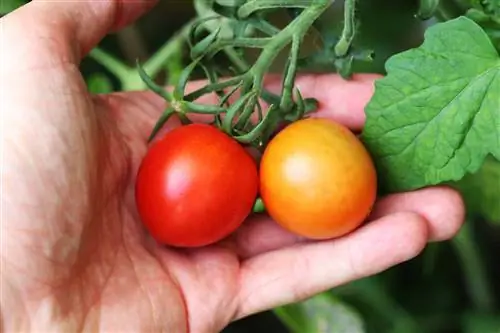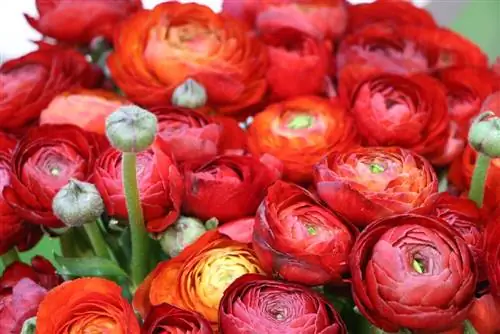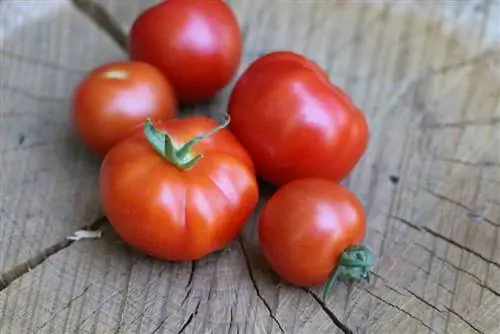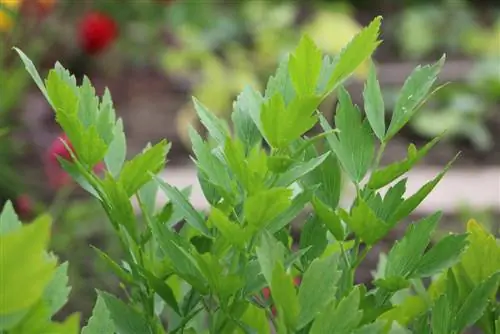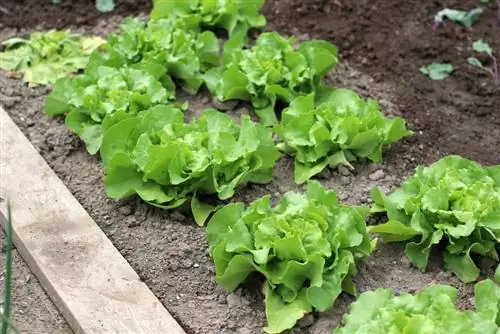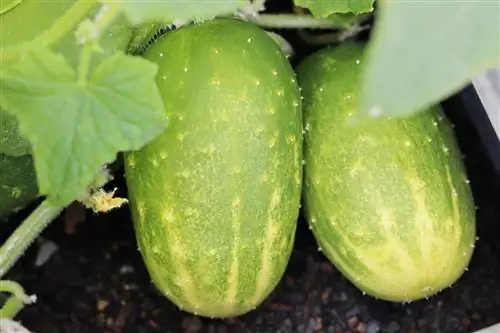- Author admin [email protected].
- Public 2023-12-17 03:39.
- Last modified 2025-01-24 12:45.
For many people, tomatoes are a must in salads and other dishes, especially in summer - they are juicy, aromatic and, above all, he althy. They are available in large quantities in stores, although there are many differences in quality. Often the tomatoes are not yet ripe enough and are harvested early in order to stay fresh for as long as possible. Of course, this has an impact on the aroma, so more and more people are looking for good alternatives to growing delicious tomatoes themselves.
The right time for sowing
Anyone who loves tomatoes knows the variety of varieties and also old varieties that are not available in stores. If you don't want to do without these varieties, the only option is often to sow them. Since tomato plants need a lot of light to thrive, you should wait until around mid-March. Then you can sow the tomato seeds in small peat pots or cultivation pots filled with sowing soil. Tomatoes do not germinate in the light, so you can cover them with 5 millimeters of soil. After watering, you should always keep the soil moist. The best way to regulate humidity is in a cold frame. However, it is advisable to ventilate it daily to exchange air. After about 10 days, the seedlings emerge from the soil. When the first pairs of leaves appear, the young plants must be pricked out. You always leave the strongest young plant standing.
Tomato plants from the trade
If you don't have the space or time to grow tomato plants, commercially available young plants are a good alternative. Of course, you don't get a huge variety of varieties here, but you still don't have to forgo growing aromatic tomato plants.
What you need to grow tomatoes
Since tomato plants are quite fragile, you will need the following utensils to grow them:
- Young plants from the trade or from your own cultivation
- an organic fertilizer
- Support rods
- Twining thread
- a small shovel
- a watering can
- ideally a rain cover or a tomato greenhouse
The right time to repot
Since tomato plants do not cope well with frost, they should only be planted outdoors after the Ice Saints. If you want to put the plants outdoors, you should wait until around mid-May. However, they can be planted in the greenhouse as early as April. To grow well, plants need a lot of light, water and nutrients, which they get from the soil. Good soil therefore offers ideal conditions. If you want to grow tomato plants in pots, they should be large enough so that the roots can develop well and supply the plants.
The right care
Tomato plants need good care for he althy and strong growth. It is important that the plants are supported so that they can bear the load of the fruit. Apart from bush tomatoes, they also need to be pruned at regular intervals. This involves pinching away the shoots that grow from the leaf axils of the main shoots with your fingernail. If possible, only one or two main shoots should be left on a plant so that the energy goes not into leaf growth but into the formation of the fruits. At the same time, the fruits get more light.
The perfect location
Tomatoes need a lot of light throughout the entire growth phase, which is why they are best placed in sunny places. Since the fruits only form when the flowers have been pollinated, care must also be taken to ensure good air circulation. Outdoors, where bees, bumblebees and the wind do the pollination work, there is much more to do in the greenhouse. Make sure there is a daily flow so that the pollen can be transferred from flower to flower. Shaking the plants gently has the same effect. In addition, tomatoes should be protected from rain and direct sunlight from the time they fruit on so that they are less susceptible to disease. A sheltered place, such as a tomato greenhouse, is particularly suitable as a shelter.
Watering tomato plants properly
Tomatoes need a relatively large amount of water, so they should be watered daily if possible, especially on warm summer days. This is particularly important during fruit formation so that the fruits do not burst open.
Fertilizing tips
Since chemical fertilizers often contain substances that have no place in food, purely organic fertilizer should be used when fertilizing tomato plants. Nitrogen-containing fertilizer pellets made from sheep's wool, horse manure or nettle manure are particularly suitable for this. When preparing the soil, the pellets or horse manure are particularly easy to incorporate, and nettle manure is a good addition when watering.
Propagation options for tomatoes
Tomato plants reproduce by transferring pollen during the flowering period. If a flower is pollinated with pollen, the tomato is formed. The core that you see in the fruit is the seed. For example, you can dry these on a kitchen towel and store them in the refrigerator for the coming year. Crossing different varieties is also possible. But you can also grow new cuttings from the shoots that have been removed from the leaf axils by letting them root in a cup filled with water.
Overwintering tomato plants
It is also possible to overwinter tomato plants in the form of cuttings. You can overwinter shoots from he althy and strong mother plants by placing them in a glass of water. However, this is relatively time-consuming and is usually only worthwhile for very rare tomato varieties that only produce poor seeds. Since the cuttings need a lot of light, you need a suitable lamp.
Diseases and pests
Tomatoes are quite vulnerable plants if they don't get the care they need. Many illnesses can be traced back to incorrect posture and care. Widespread diseases include, for example, fruit and stem rot, late blight or brown rot, dry spot disease, powdery mildew or gray mold, blossom end rot, spoonwort or green or yellow collar caused by too much sun. These diseases are often caused by excessive sunlight, periods of drought, lack of nutrients or rain from above. You can usually tell whether a plant has one of these diseases by looking at its leaves or fruits.
Interesting facts
You only plant in the garden after the Ice Saints. The planting distance should be 50 to 60 cm. The planting hole must be quite deep. It is filled with compost base. You plant the perennial at a slight angle and new roots will develop from the stem. The plant can be planted up to 5 cm below the first leaves. This has the advantage that roots can form on the entire underground stem. This strengthens the plant and allows it to grow vigorously. Water well after planting.
Tomato plants can also be planted in containers. Pots with a capacity of at least 5 liters are best. They should be placed in front of a south wall.
The plants need a support, a rod that gives them support.
The best location for tomatoes is in a greenhouse. If you have the opportunity, you should only plant them there. Rain damages the plants and if you're unlucky, they die. It is better to keep the leaves dry. That's why tomato plants are particularly well looked after in the tomato greenhouse. You only water at the bottom of the plant, not on the leaves.
If you have not prepared the soil before planting as described above, you should add a strong starter fertilizer to the planting hole when planting.
You can buy tomato plants in different sizes or you can sow them yourself. This is best started in mid to late March. Potting soil is suitable as soil; it is germ-free. The seeds should be about 2 cm apart and only lightly covered with soil. The safest way to moisten them is with a spray bottle. They need a bright location and temperatures around 20 ºC to germinate. As soon as the first two cotyledons of the young plant have developed well and the first leaves become visible, the plants are separated. As soon as there is no longer any threat of frost, the young plants are transplanted into the garden or into an appropriate pot.

